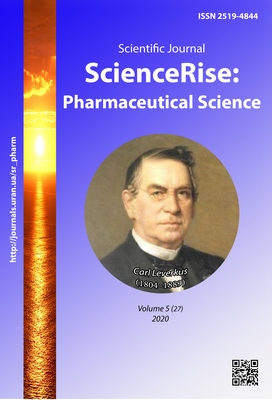Development of RP HPLC method for aminocaproic acid determination in a complex nasal drug
DOI:
https://doi.org/10.15587/2519-4852.2020.215397Keywords:
RP HPLC, aminocaproic acid, dansyl chloride, complex nasal drugAbstract
The aim of this work was to develop a method of RP HPLC for the quantitative determination of aminocaproic acid in a complex nasal drug.
Materials and methods. A solution of aminocaproic acid and a solution of a complex model mixture containing aminocaproic acid were used for the study purposes. A method used for sample preparation was derivatization of aminocaproic acid with dansyl chloride. A method of quantitative determination was RP HPLC analysis with UV detection at 288 nm.
Results. The obtained data confirm the specificity, linearity, and correctness of the method proposed for quantitative analysis. Therewith, the correlation coefficient, limit of detection, limit of quantification and relative standard deviation (RSD) are R=0.9998, LOD=4.6·10-5 g/mL, LOQ=1.4·10-4 g/mL, and RSD=1.16% respectively.
Conclusions. A method of RP HPLC for the quantitative determination of aminocaproic acid in a complex nasal drug has been developed and its validation assessment has been carried out according to the following validation parameters: specificity, accuracy, linearity, and precision (repeatability). Statistical processing of the obtained results shows that all the validation parameters studied are within the acceptance criteria
References
- Van Asten, L., Luna Pinzon, A., de Lange, D. W., de Jonge, E., Dijkstra, F., Marbus, S. et. al. (2018). Estimating severity of influenza epidemics from severe acute respiratory infections (SARI) in intensive care units. Critical Care, 22 (1). doi: http://doi.org/10.1186/s13054-018-2274-8
- Muscatello, D. J., Amin, J., MacIntyre, C. R., Newall, A. T., Rawlinson, W. D., Sintchenko, V. et. al. (2014). Inaccurate Ascertainment of Morbidity and Mortality due to Influenza in Administrative Databases: A Population-Based Record Linkage Study. PLoS ONE, 9 (5), e98446. doi: http://doi.org/10.1371/journal.pone.0098446
- Lum, M. E., McMillan, A. J., Brook, C. W., Lester, R., Piers, L. S. (2009). Impact of pandemic (H1N1) 2009 influenza on critical care capacity in Victoria. Medical Journal of Australia, 191 (9), 502–506. doi: http://doi.org/10.5694/j.1326-5377.2009.tb02914.x
- Shaman, J., Karspeck, A. (2012). Forecasting seasonal outbreaks of influenza. Proceedings of the National Academy of Sciences, 109 (50), 20425–20430. doi: http://doi.org/10.1073/pnas.1208772109
- Moa, A., Muscatello, D., Chughtai, A., Chen, X., MacIntyre, C. R. (2019). Flucast: A Real-Time Tool to Predict Severity of an Influenza Season. JMIR Public Health and Surveillance, 5 (3), e11780. doi: http://doi.org/10.2196/11780
- Zarychanski, R., Stuart, T. L., Kumar, A., Doucette, S., Elliott, L., Kettner, J., Plummer, F. (2010). Correlates of severe disease in patients with 2009 pandemic influenza (H1N1) virus infection. Canadian Medical Association Journal, 182 (3), 257–264. doi: http://doi.org/10.1503/cmaj.091884
- Săndulescu, O., Drăgănescu, A., Pițigoi, D. (2019). Influenza redefined – clinical and epidemiological insight. Germs, 9 (2), 60–60. doi: http://doi.org/10.18683/germs.2019.1158
- Clinical Aspects of Pandemic 2009 Influenza A (H1N1) Virus Infection. (2010). New England Journal of Medicine, 362 (18), 1708–1719. doi: http://doi.org/10.1056/nejmra1000449
- Kalil, A. C., Thomas, P. G. (2019). Influenza virus-related critical illness: pathophysiology and epidemiology. Critical Care, 23 (1). doi: http://doi.org/10.1186/s13054-019-2539-x
- Sellers, S. A., Hagan, R. S., Hayden, F. G., Fischer, W. A. (2017). The hidden burden of influenza: A review of the extra-pulmonary complications of influenza infection. Influenza and Other Respiratory Viruses, 11 (5), 372–393. doi: http://doi.org/10.1111/irv.12470
- Armstrong, S. M., Mubareka, S., Lee, W. L. (2013). The lung microvascular endothelium as a therapeutic target in severe influenza. Antiviral Research, 99 (2), 113–118. doi: http://doi.org/10.1016/j.antiviral.2013.05.003
- Nicholls, J. M., Bourne, A. J., Chen, H., Guan, Y., Peiris, J. M. (2007). Sialic acid receptor detection in the human respiratory tract: evidence for widespread distribution of potential binding sites for human and avian influenza viruses. Respiratory Research, 8 (1). doi: http://doi.org/10.1186/1465-9921-8-73
- Zhigunova, A. K. (2014). Acute respiratory infections: main manifestations, mechanisms of development, symptomatic and pathogenetic therapy. Ukrainian medical journal, 1 (99), 61–66.
- Compendium on-line. Available at: http://compendium.com.ua Last accessed: 12.09.2019
- Lozitsky, V. P. (2008). Anti-Infectious Actions of Proteolysis Inhibitor ε-Aminocaproic Acid (ε-ACA). National Institute of Allergy and Infectious Diseases, NIH, 193–198. doi: http://doi.org/10.1007/978-1-59745-569-5_20
- Boyko, M., Nefedova, L., Sagaydak-Nikitjuk, R., Zhukovina, O., Osolodchenko, T., Lozitskiy, V. (2020). Pat. No. 118972 UA. Pharmaceutical composition for local treatment and prevention of upper respiratory tract infection diseases. MPK: A61K9/08, A61K9/12, A61K31/00, A61P31/02, A61P31/16, A61P37/04. No. u 201613542. declareted: 28.12.2016; published: 11.09.17, Bul. No. 17.
- Nefedova, L., Boyko, N., Starosila, D., Rybalko, S., Zhilyakova, E., Novikov, O. et. al. (2017). In vitro study of anti-influenza activity of para-aminobenzoic acid and prospects of nasal drug development on its base. Annals of Mechnikov Institute, 2, 20–22.
- Nefedova, L. V., Sahaidak-Nikitiuk, R. V., Zhukovina, O. V., Ribalko, S. L., Starosila, D. B., Valovaja, K. G. (2019) In vitro study of anti-influenza activity of the combination of para-aminobenzoic acid and ε-aminocaproic acid. Pharmacom, 3, 35–40.
- Zhang, L., Mao, S. (2017). Application of quality by design in the current drug development. Asian Journal of Pharmaceutical Sciences, 12 (1), 1–8. doi: http://doi.org/10.1016/j.ajps.2016.07.006
- Alexeeva, K. A., Pisarev, D. I., Malyutina, A. Y., Boyko, N. N. (2019). Development of methods for determination of specific impurities in the glutationion restored substance. Pharmacy & Pharmacology, 6 (6), 535–547. doi: http://doi.org/10.19163/2307-9266-2018-6-6-535-547
- State Pharmacopoeia of Ukraine (2001). Kharkiv: Rireg, Scientific and expert pharmacopoeia center, 556.
- Barsukova, Yu. N., Melnikova, O. A., Melnikov, M. Yu. (2018) Development and validation of spectrophotometric technique of determination of aminocaproic acid in a multi-component hemostatic agent. Drug development & registration, 1 (22), 76–83.
Downloads
Published
How to Cite
Issue
Section
License
Copyright (c) 2020 Lilia Nefedova, Rita Sahaidak-Nikitiuk, Mykola Blazheyevskiy, Svetlana Barnatovych

This work is licensed under a Creative Commons Attribution 4.0 International License.
Our journal abides by the Creative Commons CC BY copyright rights and permissions for open access journals.








